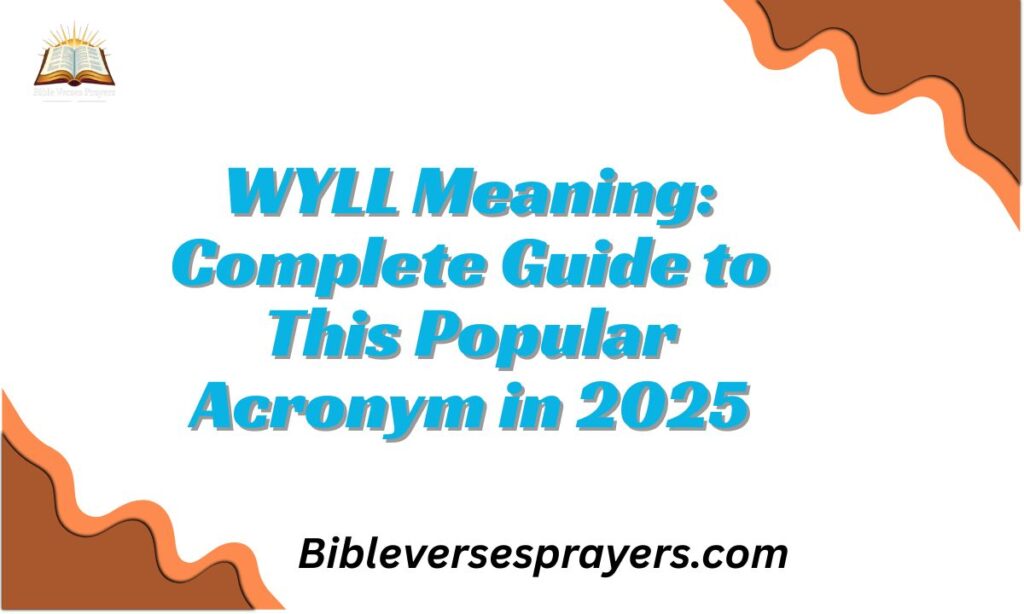Welcome! If you’ve been scrolling through Snapchat, TikTok, or Instagram and come across “WYLL” in messages or comments, you’re probably wondering what it means and how to use it.
WYLL is one of the most popular internet slang terms in 2025, especially among Gen Z users. It’s become a staple of online communication, particularly in dating apps, social media DMs, and casual conversations.
In this comprehensive guide, we’ll explore everything you need to know about WYLL—from its literal meaning to its cultural significance, proper usage, variations, and much more. Let’s dive in!
Literal Meaning of “WYLL”
At its core, WYLL is a straightforward acronym that represents a simple question, but its usage and implications go much deeper than you might expect.
What Does “WYLL” Mean?
WYLL stands for “What You Look Like” or sometimes “What Do You Look Like.”
It’s an abbreviation used primarily in online conversations when someone wants to see what another person looks like. The acronym is a direct request for a photo, selfie, or physical description of the person you’re talking to.
Pronunciation:
- WYLL can be pronounced as individual letters: “W-Y-L-L”
- Some people say it as a word that rhymes with “will”
Common Variations:
- WYLL? (with question mark)
- wyll (lowercase)
- Wyll (capitalized first letter)
The term emerged from the need for quick, efficient communication in the fast-paced world of social media and instant messaging, where brevity is valued and typing full sentences can feel cumbersome.
Origin and Evolution of WYLL
Understanding where WYLL came from helps us appreciate how internet slang evolves and spreads across different platforms and communities.
The Birth of WYLL
WYLL originated in the early 2020s as texting and social media communication became increasingly abbreviated. Like many internet acronyms (LOL, BRB, SMH), WYLL emerged from the desire to communicate quickly and efficiently, especially on platforms where character limits or rapid-fire conversations made brevity essential.
The acronym gained particular traction on:
- Snapchat: Where visual communication is central
- Instagram DMs: For connecting with new people
- TikTok comments: In response to anonymous or faceless accounts
- Dating apps: As an icebreaker or way to verify profiles
- Discord servers: When meeting new online friends
How WYLL Spread Across Social Media
WYLL’s popularity exploded primarily through:
- Snapchat Culture: Snapchat’s emphasis on photo-sharing and temporary content made WYLL a natural fit. Users would send “WYLL?” as a casual way to request a snap or selfie.
- TikTok Trends: TikTok creators began making videos about receiving “WYLL” messages, creating content around the awkwardness or excitement of exchanging photos with strangers online.
- Gen Z Language: Younger internet users embraced WYLL as part of their digital vocabulary, using it so frequently that it became instantly recognizable within their communities.
- Meme Culture: The phrase “WYLL?” became meme-worthy, with people creating humorous content about the expectations versus reality of exchanging photos online.
By 2025, WYLL has become so mainstream that even people who don’t regularly use internet slang recognize its meaning.
Symbolism and Cultural Significance of WYLL
While WYLL might seem like simple slang, it carries deeper cultural meanings about online identity, visual culture, and modern communication patterns.
WYLL as a Symbol of Visual-First Communication
In today’s social media landscape, visual content dominates. WYLL represents a broader cultural shift toward:
- Image-Based Identity: In the digital age, how we look has become a primary form of introduction and identity verification online.
- Visual Validation: Exchanging photos has become a standard part of establishing trust and connection in online relationships.
- Authenticity Concerns: WYLL reflects the constant need to verify that people online are who they claim to be, addressing catfishing concerns and building genuine connections.
The Psychology Behind Asking WYLL
When someone sends “WYLL?”, there are several psychological motivations at play:
- Curiosity: Natural human interest in knowing who we’re talking to
- Connection: Visual recognition helps create stronger emotional bonds
- Safety: Verifying identity before deepening online relationships
- Attraction: Assessing physical appearance in romantic contexts
- Social Norms: Following expected patterns of online interaction
Privacy and Boundaries in the WYLL Era
WYLL has also sparked important conversations about:
- Digital Consent: The right to decline sharing photos without explanation
- Body Image: Pressure to present yourself visually to strangers
- Online Safety: Risks of sharing personal photos with unknown individuals
- Selective Sharing: Choosing when and with whom to share your appearance
WYLL in Popular Culture
The acronym WYLL has transcended simple texting shorthand to become a recognizable element of modern internet culture.
WYLL in Social Media Trends
TikTok Content: Creators have made countless videos featuring WYLL scenarios:
- “POV: Someone asks you WYLL” (reaction videos)
- “How to respond to WYLL” (advice content)
- “WYLL expectations vs reality” (humorous comparisons)
- “Red flags when someone asks WYLL too early” (dating advice)
Instagram Reels: Similar content has spread to Instagram, with users sharing their experiences, tips, and funny moments related to WYLL requests.
Twitter/X Discussions: The platform hosts ongoing conversations about WYLL etiquette, when it’s appropriate, and how to handle uncomfortable requests.
WYLL in Music and Entertainment
While WYLL hasn’t yet become a major lyric in mainstream music, it frequently appears in:
- Rap and hip-hop lyrics about modern dating
- Social media influencer songs and parodies
- Comedy sketches about online dating
- Podcasts discussing Gen Z communication styles
Memes and Viral Content
WYLL has inspired numerous meme formats:
- “The duality of WYLL” (showing different sides of yourself)
- “When they finally send the pic after WYLL” (reaction images)
- “Me preparing my best angle after WYLL” (relatable humor)
- “WYLL starter pack” (collections of typical responses)
How to Use WYLL: Proper Context and Etiquette
Understanding when and how to use WYLL appropriately is crucial for positive online interactions.
When to Use WYLL
Appropriate Situations:
- After establishing initial conversation: Don’t lead with WYLL; build some rapport first
- On platforms centered around meeting people: Dating apps, friend-finding apps
- When someone mentions not having profile pictures: Natural context for asking
- In mutual exchanges: When both parties are comfortable sharing
- With proper tone: Casual, friendly, not demanding or aggressive
Example Conversations:
Good timing:
Person A: “I just moved to the area, looking to make new friends!”
Person B: “Cool! What are your hobbies?”
Person B: “WYLL? I’ll send one back!”
Poor timing:
Person A: “Hey”
Person B: “WYLL?”
[Too abrupt, no conversation established]
When NOT to Use WYLL
Inappropriate Situations:
- As your opening message: Comes across as superficial or creepy
- Repeatedly after being declined: Respect boundaries
- In professional contexts: Keep business communications professional
- With minors: Safety and appropriateness concerns
- When someone has already shared photos: Redundant and potentially insulting
WYLL Etiquette and Best Practices
For Asking:
- Build conversation first
- Be prepared to reciprocate
- Accept “no” gracefully
- Don’t pressure or guilt-trip
- Consider the other person’s comfort level
For Responding:
- You’re never obligated to share photos
- “I prefer to keep things text-based for now” is valid
- Offer alternatives: “Check my profile” or “I have pics on my IG”
- Set boundaries confidently
- Trust your instincts about safety
Popular Phrases and Variations of WYLL
WYLL has spawned numerous variations and related expressions in internet slang.
Common WYLL Variations
WYLL-Related Acronyms:
- “WYLL?”: The standard question format
- “WYL”: Shortened version (What You Look)
- “WYLTM”: What You Look Like To Me (making assumptions)
- “WYLL RN”: What You Look Like Right Now (requesting current photos)
- “WYLL FR”: What You Look Like For Real (questioning authenticity)
Related Slang Terms
Similar Requests:
- “Send face”: Direct request for facial photo
- “Pic for pic”: Mutual photo exchange offer
- “Face reveal”: Often used by content creators
- “Drop a selfie”: Casual photo request
- “Let me see you”: More direct phrasing
Response Phrases:
- “Here’s me”: Accompanying photo sharing
- “Pic in bio”: Directing to profile pictures
- “Check my story”: Snapchat/Instagram reference
- “I don’t share pics with strangers”: Polite decline
- “You first”: Requesting reciprocity
WYLL in Different Contexts
The meaning and implications of WYLL can vary significantly depending on where and how it’s used.
WYLL in Dating and Relationships
Dating App Context:
On platforms like Tinder, Bumble, or Hinge, WYLL functions differently because profile pictures already exist. Here, it might mean:
- Requesting recent photos
- Asking for more casual/unfiltered pictures
- Wanting to see different angles or settings
- Verifying photos match reality
Early Dating Stages:
When meeting someone online without prior photos:
- Natural progression of getting to know someone
- Building visual connection before meeting
- Verifying compatibility and attraction
- Creating realistic expectations
Red Flags:
- Asking for WYLL immediately upon matching
- Requesting inappropriate or intimate photos
- Refusing to share their own photos first
- Pressuring after being told no
- Getting angry at filtered or selective photos
WYLL in Friendship Building
Making Online Friends:
WYLL serves a different purpose in platonic contexts:
- Creating real connections beyond text
- Humanizing online interactions
- Building trust in new friendships
- Sharing aspects of daily life
Gaming Communities:
In Discord servers, gaming platforms, or forums:
- Less emphasis on appearance
- More about putting a face to the username
- Often happens naturally over time
- Community bonding through optional sharing
WYLL in Professional Settings
Generally Inappropriate:
WYLL rarely belongs in professional contexts:
- LinkedIn connections should rely on profile photos
- Professional emails don’t include such requests
- Workplace messaging apps maintain formality
- Video calls satisfy visual connection needs
Exceptions:
- Journalists verifying source identity
- Remote team building (with professional boundaries)
- Event planning requiring photos for badges
WYLL and Online Safety
Understanding the safety implications of WYLL requests is crucial in today’s digital landscape.
Privacy Concerns with WYLL
Risks of Sharing Photos:
- Digital Footprint: Photos can be saved, shared, or misused
- Catfishing: Your photos might be stolen for fake profiles
- Doxxing: Reverse image search can reveal identity
- Harassment: Photos can be used for bullying or blackmail
- Professional Impact: Personal photos surfacing in work contexts
Protecting Yourself When Responding to WYLL
Safety Best Practices:
Before Sharing:
- Check the person’s profile legitimacy
- Verify mutual connections or shared communities
- Trust your instincts about the request
- Consider the platform’s privacy features
- Review their previous messages for red flags
What to Share:
- Use photos without location metadata
- Avoid showing identifiable backgrounds
- Consider cropped or less revealing photos
- Use platform-native photo sharing (disappearing messages)
- Keep personal details (addresses, workplace) hidden
What NOT to Share:
- Photos with identifying information (street signs, name tags)
- Images showing your location or routine
- Intimate or inappropriate content
- Photos with friends or family without consent
- Professional headshots that appear in work contexts
Recognizing WYLL Red Flags
Warning Signs:
- Immediate WYLL requests with no conversation
- Anger or aggression when declined
- Refusal to reciprocate photo sharing
- Requests for increasingly intimate photos
- Threats or manipulation tactics
- Suspicious profiles with no personal information
- Multiple accounts asking the same thing
Appropriate Responses:
If something feels wrong:
- Trust your intuition
- Decline politely but firmly
- Block if behavior continues
- Report suspicious accounts
- Discuss concerns with trusted friends
WYLL in Different Platforms
Each social media platform has its own WYLL culture and norms.
WYLL on Snapchat
The WYLL Capital:
Snapchat is where WYLL thrives most naturally:
- Platform built around photo sharing
- Snap streaks encourage daily photo exchange
- Disappearing messages reduce privacy concerns
- “Streaks” culture normalizes constant photo sharing
- Filters and lenses make sharing fun and casual
Snapchat WYLL Etiquette:
- Usually expected after adding someone new
- Snaps replace traditional photos
- Reciprocity is standard
- Quick, casual responses are normal
WYLL on Instagram
More Curated Context:
Instagram WYLL has different dynamics:
- Profile pictures already provide visual info
- WYLL might mean requesting DM photos
- Stories often satisfy WYLL curiosity
- More polished, curated sharing expected
Instagram Practices:
- “Check my posts” is common response
- Close friends stories for selective sharing
- DM photos feel more private than posts
WYLL on TikTok
Comments and Duets:
TikTok WYLL appears mostly in:
- Comments on faceless accounts
- Requests for face reveals from creators
- Video responses to WYLL trends
- Duets showing reactions to WYLL requests
WYLL on Discord
Community-Based Sharing:
Discord WYLL functions within community contexts:
- Selfie channels for optional sharing
- Gaming communities are less appearance-focused
- Voice channels reduce WYLL pressure
- Moderated servers protect privacy
WYLL on Dating Apps
Expected but Nuanced:
Dating apps have complex WYLL dynamics:
- Profile photos exist, but WYLL requests more
- Video verification features reduce need
- Asking “WYLL?” might seem redundant
- Usually means wanting recent/different photos
The Psychology Behind WYLL
Understanding why WYLL has become so prevalent reveals insights about modern communication and human psychology.
Why Visual Connection Matters
Human Nature:
Humans are visual creatures:
- 90% of information transmitted to brain is visual
- Face recognition creates emotional connection
- Physical appearance influences trust formation
- Visual memory stronger than text-based memory
Online vs. Offline:
In-person meetings automatically include visual information, but online communication lacks this dimension. WYLL bridges this gap, attempting to recreate the natural human experience of seeing who we’re talking to.
WYLL and Modern Dating Culture
The Swipe Generation:
WYLL reflects how dating has evolved:
- Visual-first impressions dominate dating apps
- Appearance plays significant role in initial attraction
- Photo exchange precedes meeting in person
- Virtual dating during pandemic normalized WYLL
Authenticity Verification:
WYLL helps combat:
- Catfishing concerns
- Fake profiles
- Misleading photos
- Bots and scammers
Social Media and Identity
Curated vs. Authentic:
WYLL exists in tension between:
- Desire for authentic connection
- Pressure to present idealized versions
- Fear of judgment based on appearance
- Need for genuine human connection
WYLL Across Different Age Groups
WYLL usage and acceptance varies significantly across generations.
Gen Z and WYLL (Born 1997-2012)
Native WYLL Users:
For Gen Z, WYLL is completely natural:
- Grew up with social media and photo sharing
- Comfortable with visual self-presentation
- Fluent in internet acronyms
- See WYLL as normal conversation progression
- Use it casually without overthinking
Platform Preferences:
- Snapchat: Primary WYLL platform
- TikTok: WYLL trends and memes
- Instagram: Secondary platform
- Discord: Gaming and community contexts
Millennials and WYLL (Born 1981-1996)
Adapting Users:
Millennials understand WYLL but use it differently:
- More cautious about online photo sharing
- Remember pre-social media era
- May find WYLL requests more invasive
- Prefer established rapport before sharing
- More likely to use full platforms (Facebook profile pics)
Gen X and Older (Born Before 1981)
Unfamiliar Territory:
Older generations often:
- Don’t recognize the acronym
- Find the concept strange or invasive
- Prefer traditional communication
- More concerned about privacy
- Less likely to engage with WYLL culture
Cultural Differences in WYLL Usage
WYLL’s meaning and appropriateness varies across different cultures and regions.
Western Culture
North America and Europe:
WYLL is widely accepted in:
- United States: Very common, especially among young people
- United Kingdom: Popular on UK social platforms
- Canada: Similar usage to US
- Western Europe: Growing adoption among youth
Cultural Norms:
- Individualistic culture supports self-presentation
- Visual culture strongly emphasized
- Social media deeply integrated in daily life
- Dating culture includes photo exchanges
Asian Culture
Varied Adoption:
WYLL usage in Asia varies by country:
- South Korea: High social media use, visual culture
- Japan: More reserved; privacy highly valued
- China: Different platforms (WeChat), similar concepts
- Southeast Asia: Growing adoption among youth
Cultural Considerations:
- Collectivist values may discourage boldness
- Privacy norms differ significantly
- Platform ecosystems are different
- Face (social standing) concepts affect sharing
Middle Eastern Culture
Conservative Contexts:
WYLL faces unique challenges:
- Privacy expectations differ
- Religious considerations affect photo sharing
- Gender interactions have different norms
- Family approval may be necessary
Latin American Culture
Social and Visual:
Latin America embraces WYLL naturally:
- Strong visual and social media culture
- WhatsApp dominates (different WYLL dynamics)
- Facebook and Instagram highly popular
- Social connections highly valued
WYLL in 2025: Current Trends
As we move through 2025, WYLL continues to evolve with changing technology and social norms.
New Technologies Affecting WYLL
AI and Filters:
Modern technology complicates WYLL:
- Advanced filters create unrealistic expectations
- AI-generated photos raise authenticity questions
- Face-swapping technology enables sophisticated fakes
- Real-time beauty filters normalize altered appearance
Verification Tools:
Platforms are responding with:
- Video verification features
- Live photo requests
- Reverse image search integration
- AI detection for manipulated images
WYLL Fatigue
Growing Pushback:
Some users are experiencing:
- Exhaustion from constant visual presentation
- Resentment of appearance-based judgment
- Preference for text-based connections
- Return to anonymous online spaces
Alternative Approaches
Beyond WYLL:
New trends emerging:
- Voice note exchanges instead of photos
- Video calls replacing photo exchanges
- Personality-focused apps de-emphasizing photos
- Augmented reality creating new sharing options
Responding to WYLL: Practical Guide
Knowing how to respond to WYLL requests confidently and appropriately is essential.
Positive Responses to WYLL
When You’re Comfortable Sharing:
Friendly Responses:
- “Sure! Here’s me 😊 [photo]”
- “This is from last week [photo]”
- “Here ya go! WYLL?”
- “Just took this [photo]”
- “Check out my profile pic, but here’s a recent one too”
Setting Boundaries While Sharing:
- “Here’s one, but heads up I don’t share too often”
- “Sure, but keep it between us please”
- “Here’s a casual one, nothing fancy lol”
Declining WYLL Requests
Polite Declinations:
Direct but Kind:
- “I prefer to keep things text-based for now”
- “I don’t usually share photos with people I just met”
- “Check my profile instead”
- “Maybe later when we know each other better”
- “I’m not comfortable sharing photos yet”
Offering Alternatives:
- “I have photos on my Instagram if you want to follow”
- “My profile pic is recent”
- “Let’s chat more first”
- “How about we do a quick video call instead?”
Firm Boundaries:
If someone persists after you decline:
- “I’ve already answered that question”
- “I’m not going to share photos, please respect that”
- “This conversation is making me uncomfortable”
- [Block/Report if behavior continues]
Reciprocating WYLL
The Exchange:
If someone asks WYLL and you’re interested:
- Offer to exchange: “Sure! WYLL too?”
- Wait for their photo before sending yours (if concerned about fairness)
- Match energy levels (casual for casual, thoughtful for thoughtful)
- Respond positively to their photo before moving conversation forward
Handling Disappointment:
If their photo doesn’t match your expectations:
- Be kind; everyone deserves respect
- Don’t ghost immediately
- Continue conversation briefly before naturally tapering off
- Never insult or make negative comments about appearance
WYLL and Mental Health
The WYLL phenomenon has significant implications for mental health and self-image.
Body Image and WYLL
Pressure and Anxiety:
WYLL requests can trigger:
- Appearance anxiety
- Fear of judgment
- Body dysmorphia concerns
- Social comparison stress
- Perfectionism around photo sharing
Healthy Approaches:
To maintain well-being:
- Remember you control what you share
- Use authentic photos, not just “perfect” ones
- Recognize filters aren’t reality
- Value connections beyond appearance
- Seek support if WYLL causes significant distress
Self-Worth Beyond Appearance
Combating WYLL Culture’s Downsides:
Maintaining healthy self-image:
- Develop identity beyond physical appearance
- Engage in appearance-neutral activities
- Build relationships not solely based on looks
- Practice self-compassion
- Limit time on appearance-focused platforms
When WYLL Becomes Harmful
Recognizing Problems:
Seek help if you experience:
- Extreme anxiety about WYLL requests
- Spending excessive time preparing photos
- Avoiding social interaction due to appearance concerns
- Depression related to online appearance judgments
- Disordered eating or body image issues linked to WYLL
Resources:
- Mental health professionals specializing in social media
- Body positivity communities
- Digital wellness apps and resources
- Support groups for social media-related anxiety
The Future of WYLL
As technology and culture evolve, what might the future hold for WYLL?
Emerging Trends
Virtual and Augmented Reality:
Future developments might include:
- VR avatars replacing traditional photos
- AR filters becoming indistinguishable from reality
- Holographic representations for online dating
- AI-generated profile images based on personality
Privacy-Focused Platforms:
Backlash against photo culture may create:
- Apps that prohibit photo sharing
- Voice and text-only dating platforms
- Anonymous social networks gaining popularity
- Verification without photo requirements
Changing Social Norms
Potential Shifts:
Future possibilities:
- WYLL becoming less socially acceptable
- Emphasis shifting back to personality and conversation
- New acronyms replacing WYLL
- Generational differences in photo-sharing norms
- Legal regulations around photo requests and sharing
Final Thoughts
The meaning of “WYLL” extends far beyond its simple definition of “What You Look Like.” This four-letter acronym encapsulates modern communication patterns, visual culture dominance, online identity formation, and the complex dynamics of digital relationships in 2025.
WYLL represents both the benefits and challenges of our connected age—the ability to form genuine connections across distances, but also the pressure to constantly present ourselves visually, the convenience of quick communication, and the vulnerability of sharing our image with strangers.






